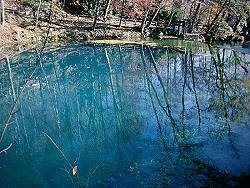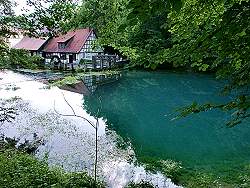Blautopf und Blautopfhöhle
Useful Information

| Location: |
In Blaubeuren. 16 km west of Ulm at the B28.
A8 exit Merklingen, towards Machtolsheim.
From Ulm exit Blaubeurer Ring, B28.
(74,Ke58) |
| Open: |
Spring: no restictions. Hammer Mill: JAN to Palm Sunday Sat, Sun, Hol 11-16. Palm Sunday to 31-OCT daily 9-18. 01-NOV to 30-NOV Sat, Sun, Hol 11-16. Movie: like Blacksmith shop, hourly. Cave: not accessible. [2006] |
| Fee: |
Spring: no restrictions. Hammer Mill: Adults EUR 1.50, Children (7-18) EUR 1, Family EUR 4. Movie: Adults EUR 2.50, Children (7-18) EUR 1.50. Cave: not accessible. [2006] |
| Classification: |
 Vauclusian Spring Vauclusian Spring
 Blue Spring Blue Spring
 River Cave
horizontal cave, Upper Jurassic (Malm) limestones. River Cave
horizontal cave, Upper Jurassic (Malm) limestones.
|
| Light: | n/a |
| Dimension: |
Yield: Average=2,160 l/s, Minimum=310 l/s, Maximum=32,000 l/s. Spring: D=35 m, T=20,6 m, 900 m². Blautopfhöhle: L=14,600 m [2018]. Hessenhauhöhle: L=8,365 m [2020]. Vetterhöhle: L=2,746 m, VR=66 m [2018]. |
| Guided tours: | self guided |
| Photography: | allowed |
| Accessibility: | yes |
| Bibliography: |
Anonymous (ny):
Blautopf und Blautal,
Wissenswertes von, um und über eine Karstquelle, Faltblatt,
Hrsg: Bürgermeisteramt Blaubeuren
( ) )
Eduard Mörike (1853): Das Stuttgarter Hutzelmännle, unter anderem: Reclam Verlag, Nr. 4755, erstmals erschienen: 1853 (  ) )online version:  Sage von der schönen Lau. Sage von der schönen Lau.
|
| Address: |
Tourismuszentrale Blaubeuren (Fremdenverkehrsverein Blaubeuren e.V.), Aachgasse 7, 89143 Blaubeuren, Tel: +49-7344-921025.
E-mail: |
| As far as we know this information was accurate when it was published (see years in brackets), but may have changed since then. Please check rates and details directly with the companies in question if you need more recent info. |
|
History

| 1718 | depth measured the first time by Prälat Weissensee. |
| 1742 | construction of a communal water plant and a grindery. |
| 1744 | construction of a ground wood mill at the Blautopf. |
| 1804 | extension of the ground wood mill with a hammer mill. |
| 1869 | conversion of the forge into a "mechanische Werkstatt" (mechanic workshop). |
| 1875 | constuction of a pump house of the Albwasserversorgungsgruppe III (water supply of the Alb). The pump, driven by water power, still works. |
| 1880 | first try to dive into the cave, which didn’t even arrive ground. |
| 1956 | workshop closed. |
| 1956 | use of the spring for the water supply of Blaubeuen stopped because of hygienic reasons. |
| 1957 | second dive. |
| 1960-1962 | exploration by Höhlenforschergruppe Göppingen-Eschenbach under the direction of Manfred Keller, discovery of the water cave. |
| 1966 | hammer mill reopened as a museum. |
| 1985 | discovery of the Mörike-Dome by Jochen Hasenmayer. |
| 1989 | Hasenmayer has an diving accident and is paraplegic, exploration pauses. |
| 1997 | Arbeitsgemeinschaft Blautopf founded. |
| 1999 | beginning of detailed survey of the first 400 m by the Arge Blautopf. |
| 2002 | start of Vetterhöhle excavation. |
| 27-SEP-2003 | Bernd Aspacher dies in a diving accident. |
| 16-JUN-2005 | dry passage at the end of the Äonendom discovered. |
| 23-SEP-2006 | 1,000 m passages and the biggest chamber of Germany discovered by Jochen Malmann and Andy Kücha. The Apokalypse is 50 m wide, 170 m long and 50 m high. |
| 29-SEP-2006 | Connection between Vetterhöhle and Blautopfhöhle discovered by Jochen Malmann and Werner Gieswein. |
| 2008 | further exploration of the Vetterhöhle now carried out by new founded Blaubeurer Höhlenverein. |
Description

The Blautopf (Blue Pot) is the beautiful, extremely blue source of the
Blau (River Blue).
There are many legends about this spring, but the most important one is rather young.
In the 19th century the famous German poet Eduard Mörike published a book called Das Stuttgarter Hutzelmännle.
Written like an old fairy tale, the background story of an shoemaker journeyman who travels from Stuttgart to Blaubeuren is used to tell varous of the old legends.
The most famous is those of a mermaid named
 Schöne Lau (Beautiful Lau).
She was not able to lough any more after her baby died, so her husband, a water king from the Black Sea, banished her to this place, until she would have loughed three times.
The straightforward locals taught her to lough again.
Schöne Lau (Beautiful Lau).
She was not able to lough any more after her baby died, so her husband, a water king from the Black Sea, banished her to this place, until she would have loughed three times.
The straightforward locals taught her to lough again.

At the shore of the Blautopf lies a medieval hammer smith, which is powered by the water from the Blautopf. The huge hammers are driven by the springwater running down a water wheel. A small Visitor Center in the same building shows a video about the exploration of the Blautopf cave. Part of this film was made by Jochen Hasenmayer using a selfmade underwater super-8-camera. It is called Tauchfahrt in das Reich der schönen Lau (Dive into the realm of the Beautiful Lau) and takes 45 min.
The river cave starts at the bottom of the blue lake 30 m below the surface with a narrow passage called Düse (nozzle). This point is very dangerous, because it can only be passed during dry times of the year, while the amount of water is very low. The cave is continually ascending and descending with drops of about 30 to 40 m. It reaches the surface of the ground water for the first time after 380 m in a 10 m long and 7 m high air filled cuppola. The next time it reaches the surface, is after 550 m in a chamber called Wolkenschloß. This chamber is 30 m long, 20 m wide and up to 25 m high. When it was first discovered in 2000 no leads could be seen from the water surface and it was not further explored.
The cave, while going up and down all the time, ascends continually, and after about 1,250 m the underwater section ends at the Mörikedom. First discovered by Jochen Hasenmayer in 1985, exploration stopped for almost two decades and it was the end of the known cave. When Hasenmayer dived in the 1970s and 1980s he had to use an huge amount of gas bottles, and he needed half a day to reach the Mörikedom. But technology evolves, and modern cave divers use a rebreather technology, where used air is cleaned from dangerous gases and saturated with fresh oxygen. The result is an enormous reduction in weight and the possibility to use scooters to dive very fast. Fast crossing of deep passage also reduces the necessary decompression times and so the modern cave divers are able to reach the dry parts in less than an hour.

Since 1997 a new generation of cave divers, who united in the club Arge Blautopf, revolutionised cave diving at the Blautopf. They started to survey the underwater cave, which resulted in the first accurate map. Hasenmayer only pulled a rope, and together with the depth metre readings he was able to create a rough side view of the cave. Now there is an accurate ground plan telling where the cave runs.
After consolidating the already explored parts, they started to discover new passages. First they found a series of waterfilled chambers, the Mörikedom, Mittelschiff, and Äonendom. They are really huge, with 5 to 10 m deep water, the ceiling about 30 m high and the passage about 20 to 30 m wide. They are divided by socalled bridges, which may be crossed above climbing or below diving. At the end of the third chamber two different passages leave, a lower waterfilled to the north with a branch off to the west and a higher dry passage to the northwest. This is the end of the diving part, as both underwater leads soon become to narrow to follow.
The newest discoveries in 2005 and 2006 were even more impressive. Following the dry passage from the Äonendom the explorers found a long passage heading northwest and then north, with enormous dimensions and impressive speleothems. Both size and decoration are exceptional for a German cave. The current end [OCT-2006] is a cavern called Apokalypse, which is about 170 m long, 50 m wide and 50 m high, and decorated with rimstone pools, dogtooth spars, helicties and more.
Another part of the story starts at a place a few hundred meters from the Blautopf. In the 1950s a local caver discovered cold air blowing out of debris. He started to dig, but when he reached the depth of a few meters the walls started to collapse, and he stopped digging. His name was Vetter, an although there was no cave, it was called Vetterhöhle (Vetter Cave).
A new approach was started by the ARGE Höhle und Karst Grabenstetten, a local caving club, in 2002. They followed the air blowing out of the debris, and after three years of massive work, they reached the first chamber called Herbert Griesinger Halle in a depth of 30 m. Now they discovered cavern after cavern, one huger than the other, but unfortunately separated by massive and dangerous collapses. Finally they reached the water level in summer 2006, and some cavers thought this could be the Wolkenschloß. They told the divers about their guess, and in the next dive they verified the connection by climbing out of the water and finding traces of the "dry" cavers.
Finally, as a connection of underwater part, new discovered dry parts and the new discovered and now connected Vetterhöhle, the Blautopf-Vetterhöhle-System has a total length of almost five kilometers, with enormous chambers and dimensions. This system prooves to be one of the biggest and most interesting caves of Germany. Obviously the first tries to create a new show cave have already been made. There are different approaches, one by developing the Vetterhöhle, one by developing the Mörikedom. Both would mean the construction of an artificial entrance tunnel. At the moment the main problem for creating the show cave is the lack of money.

|
| Blautopf Gallery |
 Eduard Mörike: Die Schöne Lau
(
Eduard Mörike: Die Schöne Lau
( Search DuckDuckGo for "Blautopf"
Search DuckDuckGo for "Blautopf" Google Earth Placemark
Google Earth Placemark ARGE Blautopf (
ARGE Blautopf ( Index
Index Hierarchical
Hierarchical Countries
Countries Maps
Maps